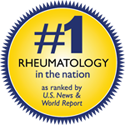The advent of the new biologic therapeutic agents in recent years has increased the concern for opportunistic infections that complicate rheumatoid arthritis (RA). In comparison to the general population, mortality rates in RA patients are higher and may be significantly associated with increased rates of infection. Hence, the objective of Doran et al. was to determine the predictors (Arthr & Rheum 46: 2294-2300, 2002) and the frequency (Arthr & Rheum 46: 2287-2293, 2002) of infection in patients with rheumatoid arthritis (RA) in a companion retrospective cohort study.
Methods: Doran et al conducted a retrospective longitudinal population-based cohort study comparing rates of infection in 609 RA patients to 609 randomly selected age and sex-matched patients without RA. Patients > 18 years of age diagnosed with RA between 1955 and 1994 were selected from a medical records system in Rochester, Minnesota. A diagnosis of RA was rejected or confirmed based upon the American College of Rheumatology (ACR) criteria. Non-RA subjects were randomly selected with a similar enrollment in the records system. Also, followup of all subjects was conducted by medical review of the entire medical record.
Infection types reviewed included: bacteremia/septicemia, septic arthritis, urinary tract infection including pyelonephritis and urosepsis, pneumonia, osteomyelitis, lower respiratory tract infections, skin and soft tissue infections, acute gastroenteritis, and intra-abdominal infections. However, data on minor upper respiratory infections was not collected. Information on accompanying fever, leukocytosis, microbiologic culture, radiologic findings, and hospitalization was also collected.
Two outcomes were analyzed, all infections with objective confirmation by culture and/or imaging and infections requiring hospitalization. Potential confounding factors for increasing the susceptibility of infection such as diabetes mellitus, neutropenia, smoking, alcoholism, chronic lung disease, and corticosteroid use and dates of onset were also evaluated.
Results: The mean age was 58 years for RA patients and 58.2 years for non-RA patients with 73.1% females in each group. Baseline characteristics of both groups were similar in terms of confounding variables of infection (diabetes mellitus, chronic lung disease, alcoholism, and leukopenia) although RA subjects were more likely to be smokers and to have exposure to corticosteroids. As a result of the increased mortality rate (P<0.0001) in the RA cohort, the mean follow-up time in the non-RA (15.0 years) cohort was greater than that in the RA cohort (12.0 years).
Infections confirmed by positive culture or imaging per 100 person-years was greater in RA patients (19.84) in comparison to non-RA patients (12.87). In RA patients, the observed ratio rate for developing infections was 1.53 (95% confidence interval [CI] 1.41-1.65). Joints, bones, skin and soft tissues were the sites with the highest observed rates of infection for the three groups of infections; infections with objective confirmation (1.53 [95% CI 1.41-1.65]), infections requiring hospitalization (1.88 [95% CI 1.71-2.07]), and physician-documented infections (1.33 [95% CI 1.26-1.41]).
Statistically significant (P< 0.016) factors associated with the greatest risk of infection in objectively confirmed infections were increasing age, male sex, smoking, alcoholism, leukopenia, organic brain disease, comorbidities (diabetes mellitus, chronic lung disease), and markers of disease severity (comprised of extraarticular manifestations of RA, positive rheumatoid factor, rheumatoid nodules, elevated ESR, and reduced functional capacity). In addition, the only medication associated with increased risk of infection was corticosteroids.
Conclusion: The results demonstrate that RA patients have twice the excess risk of developing an infection in comparison to age and sex matched non-RA patient controls. These observations demonstrate this may be due to altered T cell diversity in the immune system, immunosuppressive therapy, extraarticular manifestations of RA, and/or comorbidities. As a result, this determination of the strong predictors of infection in RA may provide a novel way to identify high risk RA patients in whom measures of prevention could be instituted to decrease the frequency of infection.
Furthermore, the results of the present study may be limited as the infection rates only reflect those receiving medical attention and does not include upper respiratory tract infections or viral infections. Also, patient functional status reflects the information available at the time of onset and may not accurately reflect functional status during disease course. Furthermore, biologic therapy was infrequently used at the time of this study (0.5%) and therefore was not examined for relevance in predicting infection risk. Finally, the observed results are representative of the US Caucasian population only due to the under representation of some racial and ethnic groups in Rochester, Minnesota.

